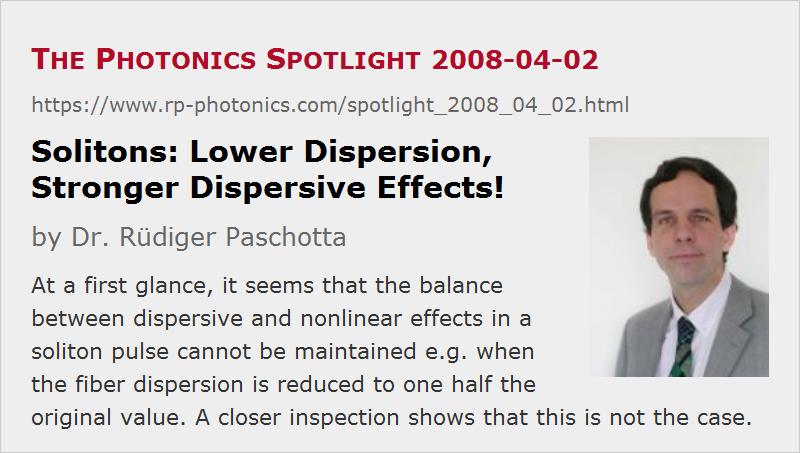Solitons: Lower Dispersion, Stronger Dispersive Effects!
Posted on 2008-04-02 as a part of the Photonics Spotlight (available as e-mail newsletter!)
Permanent link: https://www.rp-photonics.com/spotlight_2008_04_02.html
Author: Dr. Rüdiger Paschotta, RP Photonics Consulting GmbH
Abstract: At a first glance, it seems that the balance between dispersive and nonlinear effects in a soliton pulse cannot be maintained e.g. when the fiber dispersion is reduced to one half the original value. A closer inspection shows that this is not the case.

Ref.: encyclopedia articles on solitons
Soliton pulses (propagating e.g. in an optical fiber) exhibit a situation where the effects of the Kerr nonlinearity and of chromatic dispersion essentially cancel each other. It is instructive to consider one aspect which may seem quite surprising: if the dispersion of the fiber is reduced while the pulse energy stays unchanged, the pulse duration is reduced and the peak power increases. Therefore, nonlinear effects become stronger. But how can then the balance of nonlinear and dispersive effects stay in place? After all, we have less dispersion but stronger nonlinear effects!
The resolution of this conundrum is obtained by considering what exactly determines how strong dispersive effects are. It turns out that it is not just the magnitude of dispersion, but also the pulse bandwidth. For example, if we reduce the fiber dispersion by one half (while maintaining the pulse energy), the pulse bandwidth doubles. As changes in the spectral phase are proportional to the dispersion times the square of the frequency offset from the center optical frequency of the pulse, the phase shifts within the pulse spectrum scale with the magnitude of dispersion times the square of the pulse bandwidth. In our example, overall the strength of dispersive effects is doubled, and this is exactly what we need to compensate the doubled nonlinear effects resulting from the doubled peak power.
This article is a posting of the Photonics Spotlight, authored by Dr. Rüdiger Paschotta. You may link to this page and cite it, because its location is permanent. See also the RP Photonics Encyclopedia.
Note that you can also receive the articles in the form of a newsletter or with an RSS feed.
Questions and Comments from Users
Here you can submit questions and comments. As far as they get accepted by the author, they will appear above this paragraph together with the author’s answer. The author will decide on acceptance based on certain criteria. Essentially, the issue must be of sufficiently broad interest.
Please do not enter personal data here; we would otherwise delete it soon. (See also our privacy declaration.) If you wish to receive personal feedback or consultancy from the author, please contact him e.g. via e-mail.
By submitting the information, you give your consent to the potential publication of your inputs on our website according to our rules. (If you later retract your consent, we will delete those inputs.) As your inputs are first reviewed by the author, they may be published with some delay.
 |




If you like this page, please share the link with your friends and colleagues, e.g. via social media:
These sharing buttons are implemented in a privacy-friendly way!